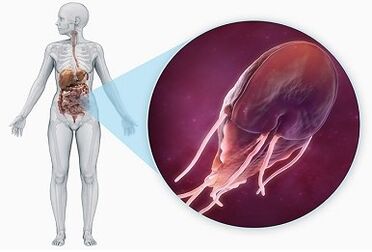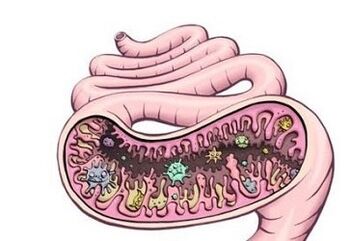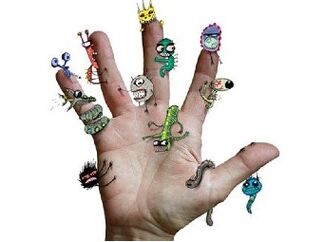Parasitism is a form of interaction interaction, in which a representative of one type (parasite) is part or completely exists at the expense of the other type (owner) representative. The list of parasitic forms that affect a person is very broad

Parasites are found between arthropods, mollusks, worms, mushrooms, simple organisms, and this is not the whole list. Bacteria and pathrot virus, from a medical point of view, are also parasites.
In this article we will talk about the forms of representatives of the Government Parasites (Protozoa). Parasites are always an unpleasant and unwanted phenomenon, so to fight them effectively, you need to know as much as they can.
Government representatives are often called unicellular organisms. These are creatures consisting of only one cell, which have a fixed form, such as ciliates, or capable of cytoplasmic movement, such as ameba.
Many protozoa are equipped with movement organs, which are represented in the form of flagella, cilia or pseudopods. Their dimensions change from microscopic to a few millimeters. The organism cage contains a set of organelle that performs functions similar to the more complex organisms.
The government is represented by nearly 15, 000 species, mostly living in aquatic and land environment.
However, there are some unicellular organisms that prefer parasitic lifestyle. The simplest parasites can cause diseases such as protozoans - sometimes taking severe form to death. Sometimes it is very difficult to get rid of parasites in the body.
Protozoa has a protective mechanism - the transfer of poor environmental conditions in inactive conditions. Cells are covered with dense shells, cannot be penetrated, turn into cysts, and in unprofessional form can be a very long time. Incest is also used by the easiest to distribute it.

Species difference
The easiest person is different in the structure, the method of introducing it into the body and causing illness. For the restructuring of the best information, the main ingredients on unicellular organisms are briefly presented in the table.
Some representatives of the parasite protozoa in the human body, their brief description:
| Type, causing disease and organ system, subject to damage | Symptom | Method of infection, carrier | Infects the parasite life cycle level |
|---|---|---|---|
| The class | |||
|
Skin leishmaniosis is characterized by the formation of necrotic ulcers in the affected area of the skin. Visceral leishmanosis causes acute inflammation reaction from the affected organs, with ulcers and bleeding. | They fall into the bloodstream with mosquito bites, with saliva. Carriers - warm animals, including humans; The carrier is a mosquito. | Promastigote (flag body shape). |
|
Enteritis, allergies, asthma, depression, nerve disorders, cracks, dry skin, cholecystitis, etc. | The path of fecal-oral infection through food and water. Carriers - warm animals, including humans; Carrier - Synanthropic insects (flies, cockroaches). | Cyst level. |
|
Itching, burning in the genital area, urinary tract discomfort, unhealthy discharge from the genitals. Complications with the development of infertility are possible. | Sexual path of infection; by mouth; through the rectum; when the air is inhaled; It is possible to send parasites while giving birth from child to child. The carrier and the carrier are people. | Any level of life cycle: flagellates (adult), amoeboid (middle, most invasive), cyst. |
|
Increased lymph nodes, pathological processes in the spleen, damage to the nervous system is characterized by excessive drowsiness, and fatal outcomes often occur. The disease has developed for up to two years. | Enter the bloodstream during the insect bites with their saliva; When pouring blood. Carriers are warm animals, including humans, carriers - tseche flies (African tripanosomosis), tritomic bugs (American tripanosomosis). | The level of trypomastigote (a membrane swing feature and the ability to move). |
| Spore class | |||
|
Latent and chronic forms continue without symptoms; Symptoms of acute forms are indicated from the affected organs. The most dangerous for pregnant women and newborns leads to serious disorders and congenital pathology, until the death of the fetus. | Roads of fecal-oral infection through unprocessed milk, meat; with insect bites; During pregnancy from mother to child. Harshes and carriers are warm animals, including humans. | Cyst level. |
|
Increased body temperature, chills, fever, can cause serious wounds from the kidneys, nervous system, fatal outcome is possible. | Enter a person's blood flow during bite with insect saliva; Delivery during pregnancy from mother to child; When pouring blood. The carrier is a person, the carrier is a malaria mosquito. | Sporosoit level (last form of sporik's sexual cycle). |
| Infusoria class | |||
|
The ulcer of the intestinal mucous membrane is accompanied by blood diarrhea, and fatal outcomes often occur. | The path of fecal-oral infection through fruits, vegetables, unprocessed pork. The carrier is a pig, a carrier - a synthropic insect (flies, cockroaches). | Cyst level. |
| Sarcodes class | |||
|
Asymptomatic and demstrative form a form of disease. Intestinal amoebiasis is indicated by bleeding and vomiting; Additional amoebiasis characterized by acute liver lesions, lungs and other organs. | Roads of fecal-oral infection through vegetables, fruits, vegetables; Anal sexual relations. The carrier is a warm, often, human, carrier - sinantropic insects (flies, cockroaches). | Quad -Core Systs level. |
As a rule, for all protozoa, a very complex and multi -multi -lifelong cycle is characterized by a very complex and multi -passing life cycle, which includes different forms, activity levels and functional stages of the stage.
Unicellular organisms most commonly occur by simple cell division in two, but some classes, together with divisions, also exist in a more complex reproductive process with the exchange of genetic information, for example, representatives of Flagella class.
In addition, the form of protozoa life is not universal for all classes. Various stages of parasite life cycle can occur in different animal species organisms.

Therefore, some of them are permanent owners, parasitic carriers, while others play a role in infection carriers. Also, the individual level of life cycle can occur in the same individual, but in different organs.
Symptoms of intrusion depend on the level of parasite life cycle, at the resistance of the human body, at the level of infection and localization. Often the disease is accompanied by non -specific symptoms, as a result of the diagnosis of infection with protozoa is always very difficult.
According to the latest WHO data, more than 1 billion people are infected with parasites. The worst thing is that parasites are very difficult to detect.
- anxiety, weakness, drowsiness;
- frequent headaches;
- itching, allergic reactions;
- odor from mouth, teeth plaque and language;
- weight change;
- diarrhea, constipation and abdominal pain;
- Increased chronic disease.
All of these are the possible signs of parasites in your body. Parasites are very dangerous, they can cause fatal disease. Diseases caused by parasites take a chronic form.


















